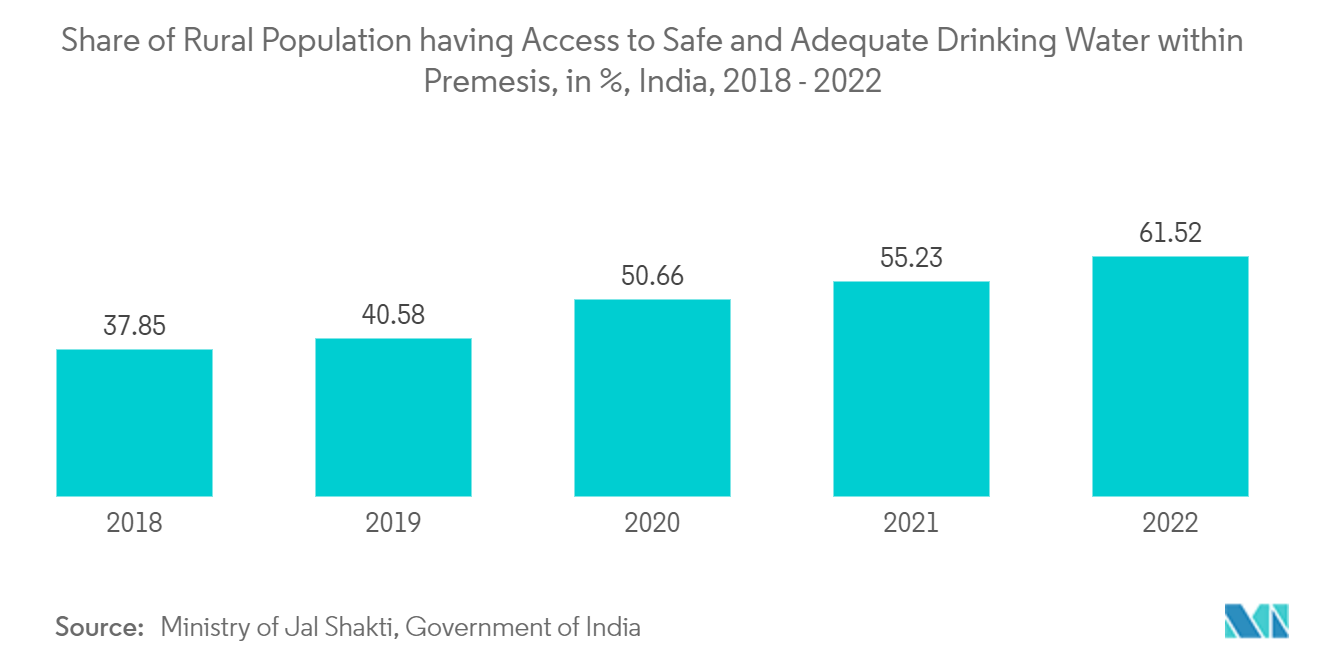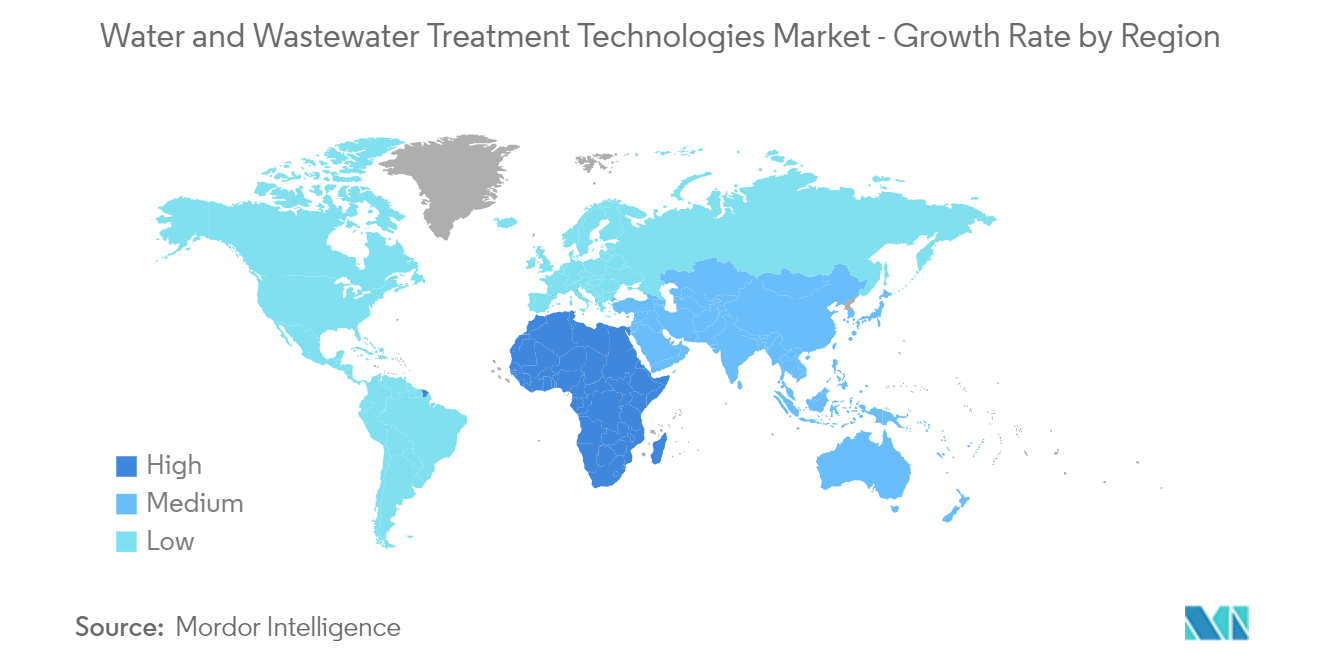Market Trends of Water And Wastewater Treatment Technologies Industry
Municipal Water and Wastewater Treatment Segment is Expected to Dominate the Market
- Municipal wastewater is the water draining from toilets, showers, sinks, bathrooms, washing machines, dishwashers, and liquid industrial waste. Municipal wastewater should be treated before releasing it into the environment to avoid damage to the environment and the spreading of harmful diseases.
- The major applications of treatment technologies include preliminary treatment, primary and secondary treatment, tertiary treatment, biological nutrient removal (BNR), resource recovery, energy generation, and others.
- There are nearly 1,944 municipal wastewater treatment plants across China's city/urban regions and 1,599 municipal wastewater treatment plants across China's counties. It accounts for daily processing capacities of 140 and 29 million cubic meters, respectively. In the 14th five-year plan (FYP), China published new guidelines for wastewater reuse. It mandated raising the proportion of sewage that must be treated to reuse standards to 25% by 2025.
- Due to various government initiatives, water purification is expected to increase significantly during the forecast period. With the 2030 Water Resources Group, the Council on Energy, Environment, and Water (CEEW) plans to improve wastewater management in India and increase private investments in water treatment chemicals manufacturing companies to build wastewater treatment facilities and raw materials.
- Furthermore, Stormwater Treatment Area 1 West Expansion project involves the construction of water treatment facilities on 2,509ha of land in Florida, the United States, with an investment of USD 170 million.
- Wastewater technology is primarily used in municipal wastewater treatment by the municipal authority of various cities across India. According to the World Bank, India, China, Indonesia, Nigeria, and the United States will lead the world's urban population surge by 2050.
- Moreover, the municipal water treatment in various municipalities in the country is observing a significant increase owing to government initiatives to provide the more rural population access to safe and adequate drinking water within their premises.
- According to the Ministry of Jal Shakti of the Government of India, in FY 2022, the percentage of the rural population with access to safe and adequate drinking water within premises increased to 61.52% from 55.23% in FY2021. Furthermore, the Indian government aims to provide 100% of its population safe and adequate drinking water within premises by 2024 or 2025. It will boost the municipal water treatment plants in the country.
- IDE Technologies, an Israeli firm, joined hands with the government of Andhra Pradesh to set up desalination plants in various states to overcome the water scarcity in the cities.
- To fulfill water scarcity, the Council on Energy, Environment, and Water (CEEW), in association with the 2030 Water Resources Group, is planning to improve wastewater management in India and increase private investments in building wastewater treatment plants.
- Over the past few years, the urban sewage capacity in India grew significantly. This growing capacity will likely drive the country's innovative water treatment technology demand.
- Hence, owing to the abovementioned factors, municipal water, and wastewater treatment technologies will likely dominate the market during the forecast period.

Asia-Pacific is Likely to Dominate the Market
- Asia-Pacific accounted for the major share of the water and wastewater treatment technologies market due to high demand from countries like China, India, and Japan.
- China is discharging more wastewater than industrial wastewater in recent times. Adding to the issue is the huge pollution problem, especially in the major industrial locations of the country. Currently, 80% of sludge in China is improperly dumped, an increasingly controversial environmental issue with urban centers scrambling to decrease pollution by improving their wastewater treatment plants (WWTPs). Therefore, it is expected to create an upside demand for the country's water and wastewater treatment technologies market.
- Chemical manufacturing applications account for a considerable share of the total freshwater withdrawal. Furthermore, increasing scarcity of fresh water and various environmental initiatives are anticipated to boost recycling and water reuse from municipal waste.
- For instance, in June 2022, China Everbright Water, an environmental protection company that focuses on water environment management, secured the expansion and upgrading project of the ZhangdianEast Chemical Industry Park Industrial Wastewater Treatment in Zibo City, Shandong Province. This project will be operated on a BOT (Build-Operate-Transfer) model, with a designed daily industrial wastewater treatment capacity of around 5,000 m3.
- China also announced the construction of 20 million m3/d of additional wastewater treatment capacity over the next 5 years.
- Moreover, according to International Trade Administration, China plans to build or renovate 80,000 km of sewage collection pipeline networks and increase sewage treatment capacity by 20 million cubic meters/day between 2021 and 2025. Therefore, creating an upside demand for the water and wastewater treatment technologies market.
- The sewage penetration rate in Japan is ~76%, with the country generating more than 2.2 million tons of sewage sludge on a dry basis. Sewage sludge contains 60-80% organic matter and constitutes a stable energy source.
- Furthermore, the Japanese food processing industry produces a wide range of foods, from traditional to processed food, for infants and older people. The food processing industry in the country is estimated to grow in the coming years, owing to the higher consumption of food and beverage products. The rising demand for packaged food is driving the food and beverage industry in the country. For instance, in March 2022, Domino's Japan opened its 900th store. It is the first Domino's Pizza Enterprises Ltd market to reach the milestone nine months after opening the Company's 800th store. Therefore, the expansion of the food and beverage industry in the country is expected to create an upside demand for the water and wastewater treatment technologies market in the country.
- Based on the above factors, Asia-Pacific is expected to dominate the global water and wastewater treatment technologies market during the forecast period.


